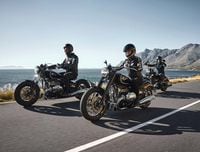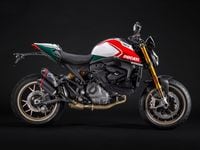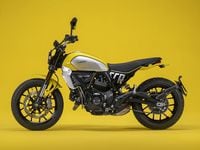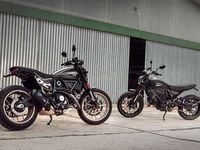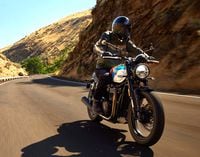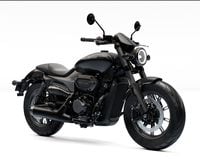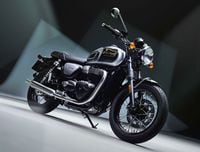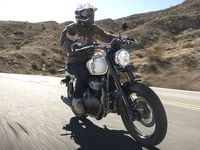Motorcycle Cruiser has had a long-running love affair with the Kawasaki Vulcan 1500 Classic. We both appeared on the scene at the same time and the Classic graced our first cover. It won our first comparison of big twins. It was our first project bike, and the first bike the magazine hopped-up.
Kawasaki likes it pretty well, too. It quickly became the company's best-selling bike in America and spawned four more models, including this one, and a line of accessories. The Vulcan 1500 Nomad, introduced in 1998, and recently released Nomad FI (fuel injection) were the touring variations of the bike. The Vulcan 1500 Drifter, introduced last year, was the retro rendition. While those models owed much to the original 1500 Classic, each also brought something new to the party. For example, the Nomad introduced a stiffer frame and new steering geometry and many smaller developments. The Drifter brought fuel injection. Appropriate innovations found their ways to the Classic.
Now Kawasaki has introduced an additional version of the 1500 Classic, combining the best of all those improvements and bringing some new pieces that are, thus far, all its own. The Vulcan 1500 Classic FI designation highlights the fuel injection, which is similar to the new Nomad's but tuned for the Classic's cruising role instead of touring duty. Inside the cases, a new alternator provides additional wattage to handle the increased electrical load of the fuel-injection system.
But bigger changes are apparent elsewhere. We are split on whether the new 5.0-gallon fuel tank or the frame is the bigger deal, but we like them both. The fuel tank brings a welcome 0.8 gallons of additional fuel capacity for the 90-octane fuel required by the fuel-injected motor (which also has a bit more compression than the carbureted model). That means revised fuel-tank contours, which are enhanced by its seamless construction. No longer is there a bottom seam subtly cluttering the lower line of the tank. The view of the engine seems less obstructed, too. The tank is slightly wider, something we saw rather than felt. There is a new tank badge.
Atop the tank you'll find entirely new instrumentation in a chrome panel similar to the other 1500s'. The speedometer looks different and is driven from the output side of the drivetrain. The fuel gauge is also different from its predecessors, though it's in the same place. Because a reserve system isn't suitable for the fuel-injected engine, a low-fuel light is added and the warning lights and their panel are rearranged. The biggest change from all previous Vulcan 1500 instruments, however, is the switch from mechanical odometer and tripmeter to a single LCD that combines both functions plus a clock. And the display is large enough to read easily. The panel includes two buttons to control the LCD, and the tripmeter can only be reset at a stop. Since there's no petcock and because the instruments are different, owners of earlier Vulcans won't find it easy to adapt this tank to their bikes.
The fuel tank isn't the only change that gently rearranges the lines of the Classic. The frame's steering head is repositioned slightly farther forward, which alters the view from the rider's seat subtly. The fork legs have been moved slightly farther apart and feature cartridge-type internals. The headlight is now a multi-reflector type and it's backed up by a chrome filler panel bridging the fork tubes. The headlight is the most obvious way to distinguish this bike from the carb-sucker.
The Classic FI gets a Nomad-style saddle, and the rear brake caliper is now a four-piston type. The angle of the rear brake pedal has been altered to make it easier to cover. Your fingers wrap around the wide-blade handlebar control levers introduced on the Nomad. The shifting mechanism has been altered to smooth shifts, and it gets directions via a Nomad-style linkage.
Kawasaki anticipates that the carbureted 1500 Classic will be more popular, mostly because of the $800 price difference, and plans to make two carbureted models for every FI. The company expects to have the bike in dealerships in April, but when we were asked if we wanted to ride a production prototype built for brochure and other photography, we leapt at the chance. (A production prototype is a bike used to evaluate the proposed assembly procedures. It's run down the assembly line as a test of the line. Most of the components are usually production pieces, but some things may change as a result of issues that arise from the procedure. We have ridden such prototypes that had noticeable shortcomings compared to the final production versions.) We expect production versions to be visually identical, but there may be slight functional differences from this machine.
The Classic FI's visual differences are small, but they add up to a bike that, at least to our eyes, is significantly more appealing. The tank is probably the largest single factor in this transformation, but if we hadn't been told it was new it would have taken usa few minutes to notice it. Viewed in a straight profile, the more forward position of the steering head is apparent. Certainly, the cherry-red paint of this bike, which is contrasted by tank stripes and fender panels that Kawasaki calls gray and we'd call a muted gold, is eye-catching.
You notice functional differences as soon as you start it. Fuel injection requires no choke for cold starts, and the engine responds cleanly to throttle after just a few seconds. Our impression is that the bike accelerates somewhat quicker at low rpm compared with both the fuel-injected Nomad and the carbureted Drifter. We will have a better idea when we ride a production model. The shifting, which still uses a heel-toe arrangement, might be slightly smoother, but we had no complaints about previous five-speeds either. Our average fuel mileage was 39 miles per gallon, which would give a 195-mile range if you used the full five gallons. We'd expect better mileage in steady highway riding on a bike that was completely broken in. Ours had less than 100 miles when we received it.
The chassis differences are more apparent than are those in the engine bay. This frame is significantly stiffer, making the FI much more stable in fast corners than the carbureted Classic. The repositioned steering head adds an additional 1.6 inches of trail (for a total of 6.4 inches) to the steering geometry, which doubtlessly contributes also. Because the steering head remains at 32 degrees, low-speed steering is minimally affected, and even the change in high-speed steering effort is barely noticeable.
The cartridge front suspension is slightly better controlled than other stock Classics we have ridden. The ride is no less comfortable, but there is slightly less braking dive and less pitching over bumps. However, the rear suspension on this prototype suffered from a shortness of rebound damping. It was similar to previous Classics but more noticeable because the front suspension is more effective.
New brake pads and the four-piston caliper in back provide a more immediate response to braking inputs and perhaps better power at highway speed compared with previous Classics. As with other Vulcans, the handlebar levers have thumb wheels that permit you to instantly adjust the lever span to fit your hand. The limiting factor in braking continues to be the tires, which are the same sizes as the carbureted Classic's rubber.
The new saddle promises improved comfort, although we didn't ride it long or far enough to tell if it will be as good as the Nomad seat. Its angle and roominess were appreciated by all that rode it.
The instruments are readable day and night, and the LCD clock is a welcome addition to the package. The warning lights aren't as bright as those on previous panels but are still visible in sunlight.
The features of this new Classic are also significant because some of them will almost certainly turn up on other models in the Vulcan 1500 series. We would expect the five-gallon tank to appear on next year's Nomad, at least the FI. (We actually expected in on this year's model.) Perhaps a petcock will be added and it will also grace the carbureted versions of both machines. This frame might also turn up on future Classics.
After riding this machine, we'd have no trouble finding the extra $800 if we were going to buy a Vulcan 1500 Classic. The differences add up to substantial improvements, and the more you ride it, the more you appreciate them.
Specifications
2000 Kawasaki Vulcan 1500 FI
Price: $10,799
Type: Liquid-cooled 1470cc SOHC 50-degree V-twin
Transmission: 5 speeds, shaft final drive
Front suspension: 41mm stanchions, 5.8 in. travel
Rear suspension: 2 dampers, 3.4 in. travel, adjustable for spring preload
Front tire: 130/90 x 16 Bridgestone G703
Rear tire: 150/80 x 16 Bridgestone G702
Fuel capacity: 5.0 gal
Seat height: 27.6 in.
Wheelbase: 65.4 in.
Additional motorcycle road tests and comparison tests are available at the Road Tests section of MotorcycleCruiser.com.










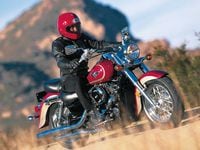
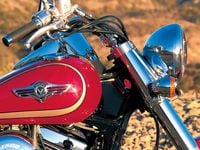
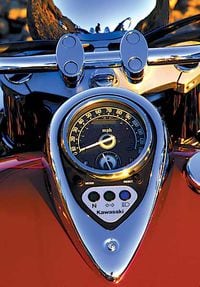
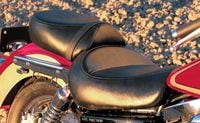
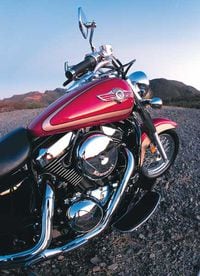
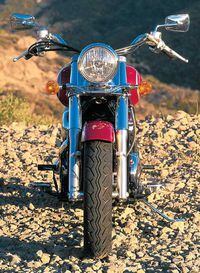
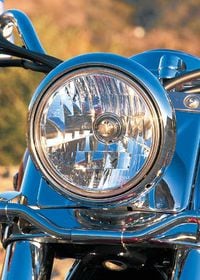
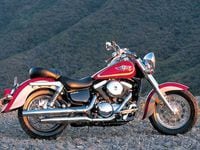
/cloudfront-us-east-1.images.arcpublishing.com/octane/H6Z2IC7WYRBXZNQS4MI3SZ5KPQ.jpg)
/cloudfront-us-east-1.images.arcpublishing.com/octane/IWO5T5PBT5E4HFQ5GK47H5YXR4.jpg)
/cloudfront-us-east-1.images.arcpublishing.com/octane/OQVCJOABCFC5NBEF2KIGRCV3XA.jpg)
/cloudfront-us-east-1.images.arcpublishing.com/octane/F3O2DGLA4ZBDJGNVV6T2IUTWK4.jpg)
/cloudfront-us-east-1.images.arcpublishing.com/octane/ZXYQE3MHLFDSPKNGWL7ER5WJ4U.jpg)
/cloudfront-us-east-1.images.arcpublishing.com/octane/RDF24VM7WVCOBPIR3V3R4KS63U.jpg)
/cloudfront-us-east-1.images.arcpublishing.com/octane/W7RSIBFISNHJLIJESSWTEBTZRQ.jpg)
/cloudfront-us-east-1.images.arcpublishing.com/octane/AERA26ENRNBW3K324YWCPEXYKM.jpg)
/cloudfront-us-east-1.images.arcpublishing.com/octane/YWX3YX7QBBHFXFDMEEEKRG4XJE.jpg)
/cloudfront-us-east-1.images.arcpublishing.com/octane/I7OKI53SZNDOBD2QPXV5VW4AR4.jpg)
/cloudfront-us-east-1.images.arcpublishing.com/octane/IH52EK3ZYZEDRD3HI3QAYOQOQY.jpg)
/cloudfront-us-east-1.images.arcpublishing.com/octane/K2FSAN7OWNAXRJBY32DMVINA44.jpg)
/cloudfront-us-east-1.images.arcpublishing.com/octane/G4XK7JL24FCUTKLZWUFVXOSOGE.jpg)
/cloudfront-us-east-1.images.arcpublishing.com/octane/JJNXVAC27ZCDDCMTHTQZTHO55Y.jpg)
